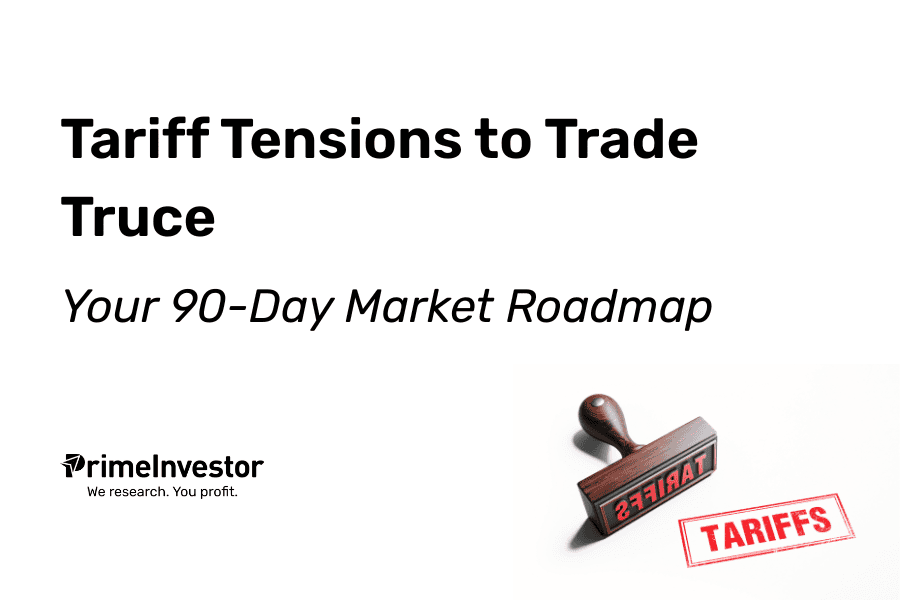Timing is everything, they say. Ours (at PrimeInvestor) was impeccable…in reverse 😊 Just less than 24 hours after the new tariffs went live, when we readied our report on the impact of Trump Tariff, we found ourselves in the economic equivalent of bringing an umbrella to a suddenly sunny day.

We are referring to the abrupt about-turn made by the US President, pausing reciprocal tariffs for 90 days across 75+ countries (except China, which received a super-sized 125% tariff in response to their 84%).
So what happens now? The baseline 10% duty remains while the rest gets a timeout until bilateral talks take place between US and other countries. There will be no reciprocal tariffs on nations except China. China has been slapped a tariff of 125%.
Whether it was skyrocketing bond yields (news is rife that Japan sold US treasury yields) or the chorus of disapproval from business leaders that prompted this pause, markets can temporarily wipe their brow.
There is now little point discussing the paused tariffs. We will therefore look at why this reciprocal tariff was flawed in the first place and what happens next.
The Trump Tariffs
We’ll begin by providing context to the tariff pause that happened on April 9.
US President Trump’s April 2 tariff announcement sent predictable but significant shockwaves through global markets. These proposed levies went far beyond simple reciprocity in trade relations, instead pursuing what most consider an impossible goal: eliminating America’s trade deficit entirely through aggressive taxation.
In 2024, the US had the largest trade deficits with China ($319 billion), the European Union ($235.6 billion), Mexico ($176 billion), and Vietnam ($129 billion). The deficit with Canada was under $100 billion ($74 billion). The table below will tell you the trade balance and the tariff slapped by US before the pause.
Tariff Backfire
The policy of reducing the US trade deficit to zero through high import tariffs has three critical flaws, among many others:
- Offshore manufacturing – a reality: For many products, manufacturing has shifted out of the US to take advantage of labour, greater labour availability or availability of natural resources in other regions. Reshoring production would dramatically increase costs. If auto giants like Ford and GM import 25-45% of their cars from outside the US, and Apple and Nike import all their iPhones and sports shoes, American consumers will bear the cost since the entire supply chain for these goods lies outside the US.
- Asymmetric spending power: Very few of America’s trading partners can match the US on income or spending power. Even if these countries were to allow import of US goods at zero tariff, it wouldn’t necessarily lead to American goods making headway in exports. Trade deficits cannot narrow without such headway.
- Capital flow disruption: The US trade deficit attracts trillions of dollars in capital into the American economy. This allows it to run up large levels of household and sovereign debt and sail through crises such as the sub-prime fiasco without much dent on its currency or markets. Trump’s view, however, seems to be that investments into dollar assets are a burden on the US economy. Without capital inflows, the US dollar cannot be global reserve currency or enjoy its safe haven status.
All this suggested that the US market was going to face the most heat from this plan. A US recession would halt high profit growth for American companies and could bring on a period of decline. This is why the US S&P 500’s 15% correction on a YTD basis was not really overdone. This has clearly spooked the Trump administration, adding to the scare of its bond yields soaring on US Treasury bonds being dumped by some countries.
Global responses to US tariff and uneven outcomes
Countries responded to US tariffs through three main strategies: retaliation, negotiation, or currency devaluation, each based on their economic leverage.
Vietnam’s rejected zero-tariff offer reveals tariff reduction isn’t Trump’s true goal. China has countered with 84% retaliatory tariffs, confident in its essential supply chain position, while facing threats of 125% US tariffs. India is pursuing negotiations toward a Bilateral Trade Agreement, potentially offering concessions, though it is unlikely to eliminate trade deficits entirely.
With the current pause in reciprocal tariffs, the Trump administration’s strategy now appears focused on securing individual trade deals. Their need for tariff revenue to address US government finances means tariffs will persist in some form, even if scaled back.
Even with all this retaliation and tariff changes, the US may see some benefits:
- EV manufacturing expansion: While complex supply chains can’t be fully repatriated, increasing domestic EV production could significantly reduce future auto imports.
- Strategic onshoring wins: Companies like Hyundai (with its $7.6B EV plant and $5.8B steel manufacturing plan) and TSMC (Arizona chip facility) are already relocating production to the US.
That said, despite isolated gains, the original broad tariff objectives remain unachievable. The current 90-day pause signals that the US wants to avoid a prolonged trade disruption that could trigger recession. This suggests a more moderate impact on export-dependent economies, company earnings, and markets than initially feared.
What ‘The pause’ means for India
Even with the reciprocal tariffs before the pause, India’s threat from the same was much lesser than many other countries. Economists estimated impact at just 0.4-0.5% of GDP versus 1-1.5% for global GDP. This limited exposure stems from relatively modest bilateral trade – only $129 billion in 2024, with U.S. exports to India at $41.8 billion against imports of $87.4 billion, creating a $45.7 billion U.S. goods trade deficit. And remember, US accounted for just 17.9% of India’s merchandise exports in 2023-24 suggesting that we remain highly diversified in our exports.
Engineering goods ($20 billion), electronics (mobile phones), pharmaceuticals, and gems & jewellery (each ~$10 billion) form India’s major exports to the US. Meanwhile, India’s key imports from the US include aircraft, pharmaceuticals, defence and security equipment, minerals, oil, and gas.
President Trump has specifically highlighted the imbalance of India’s 100% duties on Harley-Davidson motorcycles and Tesla vehicles, while Indian exports to the US in this sector face only 2.5% tariffs.
Given this context, India appears well-positioned to negotiate a deal. Reducing automotive duties from 100% to 25% would likely not trigger an import surge or threaten domestic manufacturers. Other options include increasing US oil, gas, and defence purchases to create a more balanced bilateral trade relationship.
The ultimate effect on India’s trade depends on 2 key factors:
- The final rates established through the bilateral trade agreement (BTA) under negotiation between India and the US. As part of their shared economic agenda, India and the United States have launched “Mission 500,” an initiative targeting a doubling of bilateral trade to $500 billion by 2030. Negotiations for the first phase of the Bilateral Trade Agreement (BTA) between the two nations are expected to conclude by fall 2025.
- India’s position will also be shaped by how other major trading partners respond to US tariffs, whether through retaliation or their own bilateral agreements.
The potential risks, if the tariffs continue in their present state or if some nations are left to suffer, can be broadly categorised thus:
- GDP hit: Economists expect these tariffs to dent India’s real GDP by 0.4 to 0.5% in the reciprocal tariff. A watered-down version will still mean some hit, albeit with a much lower impact.
- Capital Flight & Market Volatility: India already experienced $18.9billion FPI outflows (Oct 2024-Mar 2025) vs $21.6 billion inflows in prior period. This tariff plan could further trigger capital flight from emerging markets like India.
- Trade Partner Slowdown Effects: India’s US/Europe export exposure increased to 36% (2024) from 31% (2019). Any slowdown in these markets, owing to tariffs, will reduce demand for Indian exports.
- Chinese dump threat: Chinese imports facing higher tariffs may divert goods to India (China is already 15% of India’s imports). India implementing safeguard duties is indicative of this risk.
Relief rally dynamics in the market
- IT Sector Rebound: Among Nifty heavyweights, IT stocks were hit hardest while banking showed resilience. We anticipate IT will lead the bounce-back during this relief period as you need heavyweights to push the Nifty 50 up. However, the fundamental risk in this sector has not disappeared – India’s $340 billion IT and business services exports (primarily to the US and Europe) remain vulnerable to US economic slowdown or a potential global recession. While this secondary effect warrants caution, historical recessions have actually accelerated IT offshoring as companies sought cost efficiencies.
- India-Focused Businesses: Companies generating most revenues domestically will attract renewed interest after the correction. Quality banking and finance stocks with solid balance sheets and reasonable valuations should continue to find favour.
- Consumption Sectors: Indian consumption-facing industries enjoy multiple tailwinds and will likely be market favourites until there’s greater clarity on tariff policies.
Additionally, we’re closely watching major auto component and capital goods exporters who could gain competitive advantages from a robust India-US bilateral trade deal. We’re optimistic about this possibility and may proactively recommend select stocks in these sectors if their valuations adequately reflect short to medium-term tariff risks.
Our Prescient Investment Approach
Our recent recommendations have been strategically calibrated to weather tariff uncertainties. As we anticipated these market challenges weeks ago, we positioned our portfolio recommendations accordingly. If you’re looking to capitalize on current opportunities, consider revisiting these recent calls:
- Prime Stock Recommendation – A stock at an intersection of several growth opportunities
- Prime Stock Recommendation – A resilient automaker ready to accelerate
- Moving this diagnostics player back to BUY from HOLD
- Prime Fund Recommendation: An equity index fund to ‘buy the market’
- Prime Stock Recommendation: An NBFC player in its second innings
- Value Beyond Borders: Tactical International Investment Opportunity for 2025
- Prime Stock Recommendation: Amplifying Returns with This Diversified Electrical play
We will continue to watch events and calibrate our strategies and recommendations, across equity and debt to ensure your returns are optimal in these risky times!




6 thoughts on “Tariff Tensions to Trade Truce: Your 90-Day Market Roadmap”
On the statement, “If you’re looking to capitalize on current opportunities, consider revisiting these recent calls” —
Does it mean that the 7 recommendations are better buys within the existing recommendations? If yes, these are better buys are assuming that tarrifs are implemented or these are better buys within existing recommendations looking at current valuation irrespective of tarrifs?
The recent calls are ‘Recent buy calls’ given keeping in mind the present uncertainty. In other words, when we issued them we picked those more immune to the tariff uncertainty. But you would not have an IT call or an export-focused call in the last few weeks.That does not mean all the other Prime Stocks are not immune 🙂 For example, we have consumer focused calls given earlier that are quite immune. Kindly remember, we give recommendations. Not portfolios. How your portfolio construct is (sector and strong already overwright on) should determine which ones to add. If you have a specific question on any stock which you wish to add and whether tariff would impact them, then write to us using Contact us.
How does the US trade deficit attracts trillions of dollars in capital into the American economy? Can you please elaborate more on this point. Amercian Importers when they import goods must be paying the USD. if so, dollars should flow out of the economy. Am I missing something?
The dollar is reinvested by other nations by buying bonds of US treasury.
Hello PI Team – Nice article with detailed insights with numbers.
I have a question regarding IT exports from India to US. As per your article, it is $340B. However, in same article, the leading sectors of exports are Engg goods, electronics, pharma and Jewellery businesses. But IT is not mentioned as one of the leading sectors.
Also it is mentioned that US imports $87.4 B from India. If our IT exports are $340B, and US imports $87.4B, i m lost on why IT is not one of the leading export industries to US.
OR it is possible that numbers above cited in this article of various durations which triggered apple v orange comparisons at my end.
Please clarify. Thank you!
1. In Exports, it is important to make the distinction between merchandise exports and service exports. The $340 billion is service exports (majority being IT and the rest being financial and other services). The US import from India is merchandise imports that they take from us. It is indeed leading in service exports. But in merchandise exports US is 17.9% as given here in the govt release: https://pib.gov.in/PressReleasePage.aspx?PRID=2098447 The tariffs pertain to merchandise exports. We will be worried about IT only if there are second order impacts. Apple vs oranges comparison….we better do better than that as analysts 😊 Thanks, Vidya
Comments are closed.